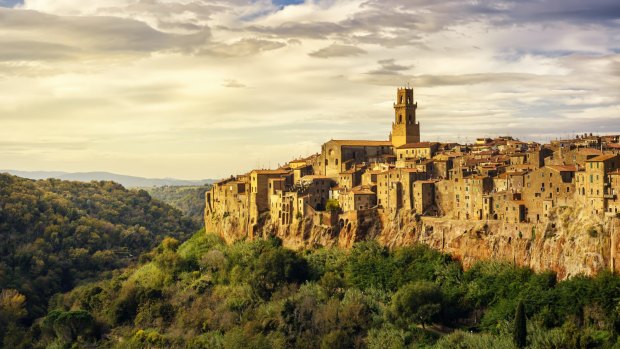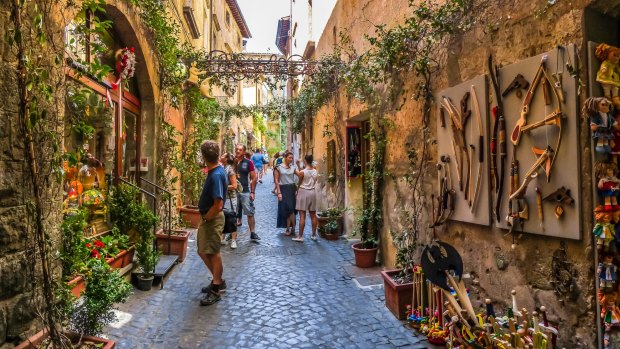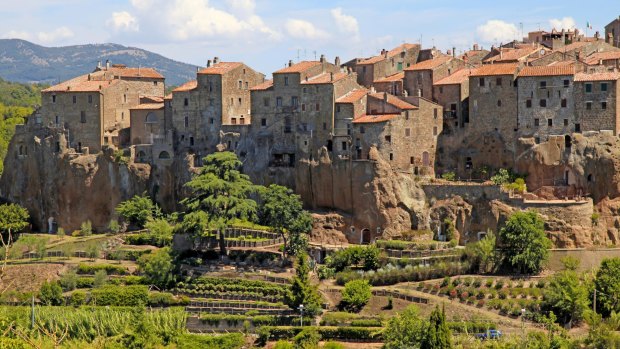This was published 6 years ago
Italy's hidden 'La Tuscia' walk: Where to go to avoid tourists
This six-day walk takes you through ancient woods, vibrant pastures and small Etruscan towns before ending in the extraordinary Umbrian hilltop city of Orvieto.
By Daniel Scott

Pitigliano medieval village.Credit: Shutterstock
For anybody concerned about over-tourism, visiting Rome and Tuscany provides ample opportunity for anxiety.
On a trip to Tuscany, I witnessed more than 100 coaches parked, bumper to bumper, on the winding approach road to the hilltop town of San Gimigniano, and was jostled by crowds in the alleyways surrounding Siena's central clam-like square.
Hidden Italy's La Tuscia walking route, does, however, promise real respite from the tourist swarms.

Ancient buildings near the Cathedral of Orvieto (Duomo di Orvieto) in Umbria, Italy,Credit: Shutterstock.com
Covering 63 kilometres over a leisurely six days, it departs the hilltown of Pitigliano, in southern Tuscany, and progresses through ancient woods and vibrant pastures and via several small Etruscan towns, before descending to Lake Bolsena, and ending in the extraordinary Umbrian hilltop city of Orvieto.
The area derives its name from the Roman word for the Etruscans, who dominated this area of Italy, straddling the borders of modern Lazio, Umbria and Tuscany's Maremma region, between about 700 and 300BC.
Described by Hidden Italy's founder Simon Tancred as "one of my favourite treks" among the many walking tours the company offers in Italy, it is, according to his copious tour notes "like going back in time".

Medieval village Pitigliano is one of several higgledy-piggledy villages sculpted out of tufa outcrops.Credit: Shutterstock
Pitigliano, where we begin, is one of several higgledy-piggledy villages, sculpted out of tufa outcrops that rear up intermittently across the region.
Small and warren-like, its winding alleys and underground caves once provided a refuge for Rome's Jewish population, escaping from persecution by the Medicis.
The enclosed village, which remains cool thanks to its narrow streets creating their own shade, is not the only impressive piece of Etruscan construction here.
In the valleys surrounding Pitigliano, along volcanic chasms, this pre-Roman civilisation opened up enormous ''cuts'', or ancient sunken roads, through the rock.
Known as ''via cava'' (plural cave), the high-sided roads lead away from hill towns, providing easy access to the rural surrounds and other villages.
Scythed as deep as three metres, running an average length of 500 metres, surrounded by oak forest and undergrowth and clad in vines, the cave dip and rise, crossing meadows and streams.
It's along these 2500-year-old cave that we spend our first warm, overcast morning, walking eight kilometres, from Pitigliano to Sovana, the second oldest continually inhabited town in Italy.
Following these ancient thoroughfares causes the imagination to wander to a time when they were used for trade. The cave are lined with grottoes dug out of the soft tufaceous rock, some reaching depths of 20m and used as cool rooms for storing goods, as well as funeral chambers.
One of the best-preserved lanes is the Via Cava di San Guiseppe, outside Pitigliano. Like a high-sided medieval alleyway through the forest, it is occasionally almost fully enclosed thanks to overhanging branches, with symbols and shrines (to ward off evil) carved into its upper levels.
Beyond the cave, the route passes through wooded valleys, where the air is cool and fresh, and I half-expect a snorting wild pig to spring from the undergrowth.
We cover the eight kilometres to Sovana by late morning, entering its main square via an ancient brick road. Although even older than Pitigliano, it feels much less labyrinthine and more open and light, with colourful flower boxes and pots outside every house.
Historically, Sorana is notable for its extensive Etruscan necropolis, at the edge of town, full of elaborately carved tombs and statues, and for its hushed cathedral, dating to the VII century.
We have both locations to ourselves and also sample superb regional cuisine in two near-empty trattoria, a lunch of home-made pasta with wild boar and a dinner of octopus soup followed by gnocchi and a pork tournedos.
Between sightseeing and eating we loll in the landscaped gardens and orchards and beside the pool of our lovely accommodation, the Hotel Sovana.
Refreshed, we trek on the next day to Sorano, a ten-kilometre walk through vineyards, olive groves, and pastures lit up by bright red poppies.
The route takes us past San Rocco archeological park, another scattering of Etruscan tombs high above the Lente river, before descending through forest to the valley beneath Sorano.
Like Pitigliano, Sorano is a village hewn out of a lofty tufa outcrop, lording it over the surrounding countryside and reached by a steep climb along a cava cut into the rock. It is capped by a sprawling medieval fort, now an atmospheric boutique hotel, where we are staying.
Besides its panoramic views, the Hotel Fortezza is distinguished by its exceptional young staff, and for the vision of its owner/manager Andrea.
A former IT entrepreneur, Andrea is trying to persuade the burghers of this less-known region to eschew the mass tourism prevalent elsewhere in Tuscany, and to concentrate on small-scale, bespoke tourism. Only that way, he insists, can they preserve its heritage and character.
After a breakfast including the sweetest, crumbliest local ricotta I've ever tasted, home-baked bread and peach jam, we are on our way again, to the village of San Quirico di Sorano.
It's an enchanting short walk passing through the thickly-wooded Lente River valley and climbing past an abandoned medieval village. Once again, we have the route almost to ourselves, save for a dog-walking local, allowing us to savour the natural and historical landscape.
Our last two days are our longest, both about 18 kilometres in distance and five hours' walking, and take us out of Tuscany and onto the shores of Lake Bolsena in Lazio, then into neighbouring Umbria.
An Aussie should feel at home in this border country, once a hotbed of outlaws and bushrangers, but it's here, as we follow the Brigand's Way on the first day, that we get badly lost, among rolling farmlands, adding five kilometres to an already long, hot day.
We recover at the aptly named Hotel Holiday beside the lake in Bolsena. An alfresco dinner of pasta with lake fish and veal scallopine with bacon followed by custardy mille-feuille dessert, in its Michelin-starred restaurant, also replaces any calories we mislaid on the extended walk.
On our final day, we get lost again, in the hills between Bolsena and Orvieto, testing our endurance and our faith in our walking notes, but the extra four kilometres add to a sense of accomplishment as we near the trek's end in the extraordinary hilltop city.
We have Orvieto in our sights for the final few kilometres, dropping down into the valley beneath it and following a well-preserved Roman road to a giant aqueduct, before cutting steeply uphill toward the old town.
Then, within a 200-metre climb of the centre, just as we are faltering, we read this in our walking guide:
"Now take the lift up from behind the car park."
It feels anachronistic to be riding an escalator into the heart of this fine Etruscan city, built onto the flat top of a volcanic tufa, and the moment we step off it, we're also reacquainted with narrow streets thick with tourists.
However, while it is far from the somnolent town I last visited in the 1980s, Orvieto can be forgiven its popularity for its 14th century cathedral alone, with its mesmerising facade lit up in the late afternoon sun and its equally luminous Signorelli frescoes inside.
We end our days in La Tuscia with the most inventive and delicious meal of our trip, a six-course, €42 tasting menu in the garden of I Sette Consoli restaurant.
Oh well, I muse, as we dine finely on tagliatelle with lobster sauce and fava beans, and pigeon casserole. Though we've loved every moment of our uncrowded walk, these tourism hotspots do have the odd advantage.
TRIP NOTES
MORE
FLY
South African Airways offers return flights from Sydney, Melbourne and Brisbane (codesharing with Virgin Australia) and flying via Perth and Johannesburg to Europe starting at $2698, including taxes. See flysaa.com
TOUR
Hidden Italy's self-guided La Tuscia walk costs from $1850 (including bed and breakfast) a person.
Daniel Scott was a guest of Hidden Italy and travelled with assistance from South African Airways.
Sign up for the Traveller Deals newsletter
Get exclusive travel deals delivered straight to your inbox. Sign up now.